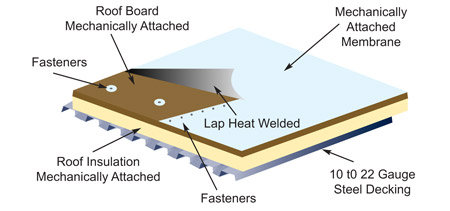Benefits Of Using The TPO Single Ply Roofing System
 Protection board or Densdeck provides the extra protection between the wood substrate and any loose fasteners or nail back outs that may occur during the life of the roofing system. This condition occurs often on wood decks, which is typical of the Northwest.
Protection board or Densdeck provides the extra protection between the wood substrate and any loose fasteners or nail back outs that may occur during the life of the roofing system. This condition occurs often on wood decks, which is typical of the Northwest.
Low impact to the tenants with regard to smoke and odor. Hot asphalt kettles and tankers emit a great deal of smoke and odor. The proposed TPO system uses no kettles or tankers. Most of the equipment is located on the roof during reroofing, with the exception of the dumpster or dump truck required to accommodate the removal of the existing roof, which will be required for both roofing systems.
TPO membranes do not exclude ponding water from the warranty and is not affected by such conditions. BUR (built up hot asphalt roofing) excludes ponding, breaks down and can support vegetation including moss and fungus.
TPO membranes do not require the ongoing resealing of penetrations, walls and curb base flashings associated with BUR’s. The annual cleaning is required of both.
TPO membranes turn up and over the top of the exterior walls to complete a watertight long-term seal prior to the installation of the sheet metal cap. Note: The membrane warranty does carry to the outside of the wall where the membrane stops. BUR systems rely on sheet metal flashing alone and stop just above the deck line typically 8”-12”.
TPO membranes have a solid white surface with one of the highest reflectivity ratings in the industry reducing solar heat gain and reducing cooling costs. TPO is ENERGY STAR rated and meets the higher standard for California’s Title 24.
TPO membranes are mold resistant, impact resistant, wind resistant, fire and traffic resistant.
Clad Metal (factory membrane laminated sheet metal) provides long term watertight details at critical locations such as pitch pans, gutter drip edge and gravel stop flashings and through wall scuppers. Please note: these items then become warranted and integrated as part of the entire system.
Toxic Leachate Test: Carlisle’s Sure-Weld TPO Roofing System has been tested, and passed the United States Environmental Protection Agency testing procedure titled Toxicity Characteristic Leaching Procedure (TCLP) as defined under 40 CFR (Code of Federal Regulations) Part 136 for EPA method 1311. This is stated in the Carlisle 2007 Sure-Weld TPO Code Approval Guide on page 32. This test is intended to protect below-grade water aquifers (drinking water) from rooftop water contamination. Ground water contamination occurs when water traveling over the roofing membrane picks up oil residues and/or other contaminants inherent to certain types of roofing systems, and are then carried into the drainage systems and ultimately into below-grade aquifers. The Sure-Weld TPO membrane is one of the few membranes on the market today that passes this test.
ENERGY STAR: Sure-Weld White TPO Membranes exceed the requirements for the United States Environmental Protection Agency Energy Star Program for reflective roofing materials.
Manufacturing of Membrane: The process of calendering or extrusion alone does not determine product quality. Carlisle has used calendering and extrusion for decades in the manufacturing of EPDM. Reinforced TPO production however, utilizes a state-of-the-art (SOTA) twin-screw extrusion technology. Carlisle’s Senatobia, Mississippi and Tooele, Utah production facilities have four SOTA extruder lines with capability up to 12-foot widths.
Each line has two extruders, one for the top ply and one for the bottom ply. The top and bottom ply sheet encapsulate (cover) the polyester fabric in the “melt state” for superior strike through and fabric yarn coverage. This produces a tightly compacted high quality membrane product, which is clearly visible under the microscope.
Membrane Sheet Widths: Carlisle manufactures the TPO membrane in various widths of 4, 6, 8, 10 and 12 feet. The different widths are used in various wind zones in accordance with building height and deck type. This allows for the roofing system to be “customized” meeting specific requirements for any given project. The design criteria for those various building conditions are outlined in the Carlisle published specifications.
Accelerated Weather Testing: Laboratory aging and weathering tests are designed to accelerate the effects of normal real-time weathering without causing changes to a membrane that would not occur during outdoor weathering. These tests include heat aging, ozone exposure, water immersion, and artificial ultraviolet (UV) weathering. Performance properties are determined before and after the aging / weathering exposure. If all of the performance properties remain at the original level (or even improve), then it is highly probable that the membrane will perform as designed. The equipment of choice for accelerating “weathering” (combined affect of heat, water spray, humidity, ozone and UV and IR radiation) is the xenon-arc weatherometer. The xenon-arc is specified in ASTM material standards for EPDM (D 4637), PVC (D4434), and TPO (G155) roofing membranes. After exposure to accelerated weather testing, the membrane specimens are removed and inspected immediately for cracks and crazing under 10X magnification while wrapped around a 3 in. (7.6 cm) diameter mandrel. Specimens are removed and inspected after each 630 kJ/m2 period of exposure. Carlisle’s minimum requirement is NC (no cracks) after 17,640 kJ/m2 at 340 nm total radiant exposure. Sure-Weld TPO xenon-arc testing normally is performed until 20,160 kJ/m2 at which point no cracks are observed. Real time outdoor weathering on Sure-Weld is performed at Atlas Weathering Service’s site north of Phoenix, AZ and west of Miami, FL.
Fire Retardant Technologies: Currently, Sure-Weld Standard, GSD, and GS membrane products use the non-halogenated flame retardant technology with NO chlorine or bromine. These non-hal membranes provide excellent weathering resistance and are environmentally friendly. Carlisle is one of few membrane manufacturers that can achieve U.L. Class A Fire Ratings on unlimited slopes, such as can be found on steep barrel roofs.
